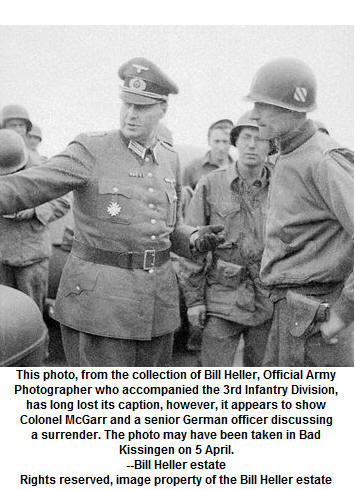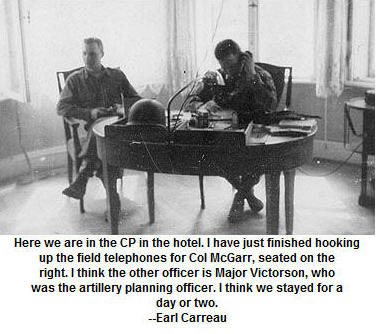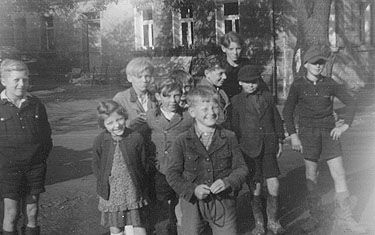| |
Sometimes side by side, sometimes leap frogging or passing through
each others lines, the 14th Armored Division and the 3rd Infantry
Division fought their way northeast through the Main, Saale and Sinn
River corridor. The area existed as a block marked by the
Aschaffenburg - Wurzburg line in the southwest running to the Fulda
- Meiningen line in the northeast. The area was to be cleared and
 secured prior to the last big push east - southeast through the
heart of Germany. Many of the small cities and towns that post war
US cavalry troopers knew as their immediate neighborhood were the
sites of sharp but brief fights as German resistance was reduced to
a series of small strong points and ambush positions. Lohr, Gemunden,
Hammelberg ..... Aura, Mittelsinn, Bruckenau ... Wildflecken,
Unsleben, Bad Neustadt .... each town remembered by US veterans as
sites were fast moving Americans encountered German resistance. And
then there was Bad Kissingen, as remembered by both the official 3rd
ID historian and the soldiers who entered the town. They were ...
secured prior to the last big push east - southeast through the
heart of Germany. Many of the small cities and towns that post war
US cavalry troopers knew as their immediate neighborhood were the
sites of sharp but brief fights as German resistance was reduced to
a series of small strong points and ambush positions. Lohr, Gemunden,
Hammelberg ..... Aura, Mittelsinn, Bruckenau ... Wildflecken,
Unsleben, Bad Neustadt .... each town remembered by US veterans as
sites were fast moving Americans encountered German resistance. And
then there was Bad Kissingen, as remembered by both the official 3rd
ID historian and the soldiers who entered the town. They were ...
The First Americans
From "History of the Third Infantry Division" Donald G. Taggert 1947
"The advance of the 30th Infantry Regiment had been a succession of
occupations and small fire fights for two days and the regiment
gathered several hundred prisoners en route. ... Leaving Ober Thulba,
Company L pushed directly east, with patrols out toward Bad
Kissingen, a world famed watering place noted for its fine springs
and numerous resort hotels, twenty -eight of which had been
converted to German military hospitals, whose red-crossed roofs had
saved the city from Allied bombing."
One of the patrols, led by 2Lt Emil T. Byke, moved along a road
leading into the city and met an officer delegation .... "
Mr. Emil T. Byke from his 2 June 2003 letter to the web site:
"We were at a halt by a small village whose name I cannot recall
when in the early afternoon (5 April 1945) one of my squad leaders
reported two vehicles at the edge of a wooded area with German
military personnel displaying a white flag. I went to verify the
report and found three military men in a vehicle. I told my Platoon
Sergeant to send a runner to the company CP to report what had
happened while I approached the Germans. I was greeted by two German
officers who, in broken English, asked if I would go with them to
the town and meet their commander. We then rode for a few miles into
the town (Bad Kissingen) where I was presented to the commander, a
General Officer. Through his interpreter, he told me that he wished
for a cease fire and wanted me to convey the message to the American
forces. I immediately agreed but before we departed, one of the
staff officers took me to a nearby hospital. Here, I was greeted by
wounded GI’s who cried with joy at seeing me. Some of the boys
hugged me and wanted to know if they were now going home. I told
them that we were at the gates of the city, I was carrying the
surrender message from the Germans and that I would return as fast
as possible. At that moment, there were two big explosions and the
German staff ran for cover thinking that an attack was underway. In
reality, it was the sound of the German military blowing up the
bridges on the Saale River. I was then escorted back to my unit
where I met the battalion commander on the road and gave a full
report. Even after all these years, I can recall that the US wounded
I encountered in the hospital had been well cared for. The bedding,
bandages and entire area was clean and orderly as any hospital you
might imagine. After so much fighting, that made an impression on
me."
Taggert continues:
"LTC Chaney, with CPT Carroll McFalls, Jr., 3rd battalion S-3 went
to the city hall with the delegation and laid down the terms of
surrender to a ranking German field officer who had been
recuperating at one of the hospitals. ... LTC Chaney made it clear
that the US would not accept an " open city " and that it would
become a base for US soldiers. This was accepted and ... Colonel
Lionel C. McGarr, Regimental Commander of the 30th Infantry was sent
for. He arrived with additional staff officers from Division and ...
the surrender of the city and 2825 German soldier - patients
occurred. .... After the fall of Bad Kissingen, the 30th Infantry
moved east and southeast and met considerable artillery and antitank
fire from the vicinity of Hambach and Maibach, outer defensive
points protecting Schweinfurt."
Carl Topie in an email message:
"As I can recall, there were numerous military hospitals in the town
and we (Company K, 30th Regiment) marched right through the town.
The wounded German soldiers glared at us as we went by the
hospitals. I don’t remember much more."
Burdell Schweibert also assigned to Company K from his unpublished
memoir:
"About the next big town we took was Bad Kissingen -- an open city
because it had many hospitals. All we had to do was just walk in and
take over. As we walked through the streets, (very clean for a
change), all the German soldiers who were wounded or sick were
looking out the windows giving us dirty looks. I especially remember
one proud Kraut. I could have shot him. He was sitting in front of a
large window with his hands folded, with medals all over his chest,
and giving everybody a dirty look. He really thought he was
somebody! We stayed in a very ritzy place that night."
Earl Carreau, from his letter to the web site:

"I do remember Bad Kissingen even though we were only there for a
day or two. It stayed in my memory for a few reasons; the city was
clean and surrendered without a fight; I accompanied the Regimental
CP and Col McGarr as a signal section sergeant and took a photo of
him in the town and because I then took one more photo and ran out
of film for the rest of the war! My signal platoon had been attached
to the 30th Regiment and then broken down into sections to support
the existing signal men in the battalions. My section had a radio
jeep and two ¾ ton trucks to deploy and retrieve wire for
telephones. Depending on what the they wanted me to do, I could run
wire to the battalions and the most forward company really fast and
then tie everyone into a mobile switchboard. When not doing this, we
guarded the CP and did other tasks as needed to include escorting
German POW’s to the rear. The CP was set up in a beautiful hotel for
a day or two just on the outskirts of town. There was no damage and
we wiped our feet as we walked in. We ran wire and I took a photo of
Col McGarr and the Artillery Planning Officer whose name I cannot
recall but it might have been Major Victorson. They are in the hotel
and talking on the phones I just set up! We slept on mattresses that
night for the first time in weeks and then, as we left, I recall the
next Army unit that followed us was trying to unsort all the German
POW’s and figure out the wounded who needed attention and so on. The
war in Germany was over about one month later."
| |

I guess this is the next morning, in the yard in
front of the hotel. All of these German kids
came over to look at us and I gave each one a piece
of hard candy. I got my camera and they knew what to
do ... grouped together and smiled. I took the
picture and then was out of film until the war ended
about one month later. I wonder if any of these kids
remember that day now?
--Earl Carreau |
|

Earl passed on in December, but he was thrilled that
people were interested in his WWII experiences and
photos. He sked if we found any more in his
house, that they be sent on. This picture was
marked, "Earl C. in Germany 1945".
--Carreau family |
|
| |
|
|
|
|
| |

This picture was marked, "Me,
right after the war ended,
near Czech border, town off-limits".
--Carreau family |
|
|
|